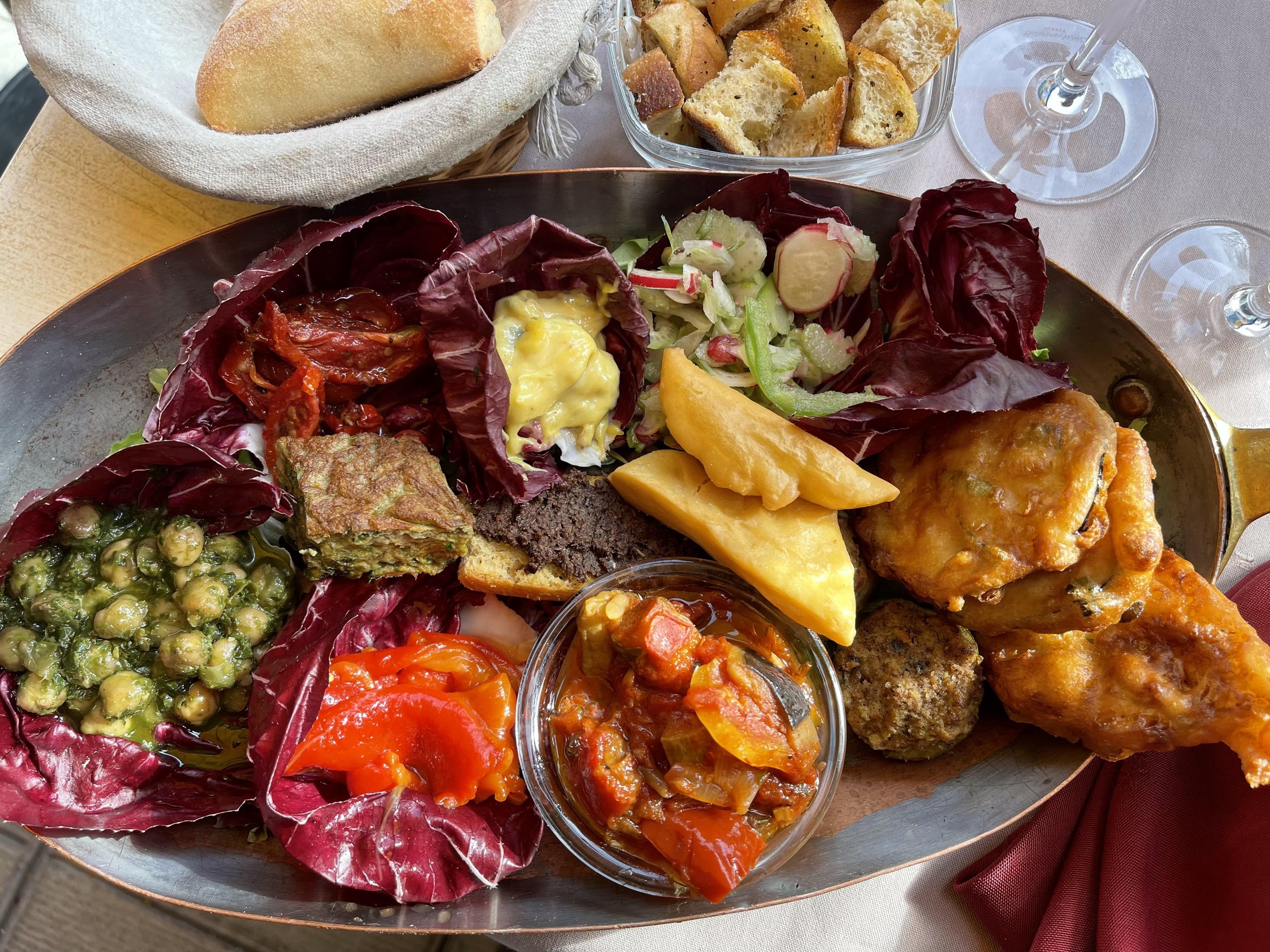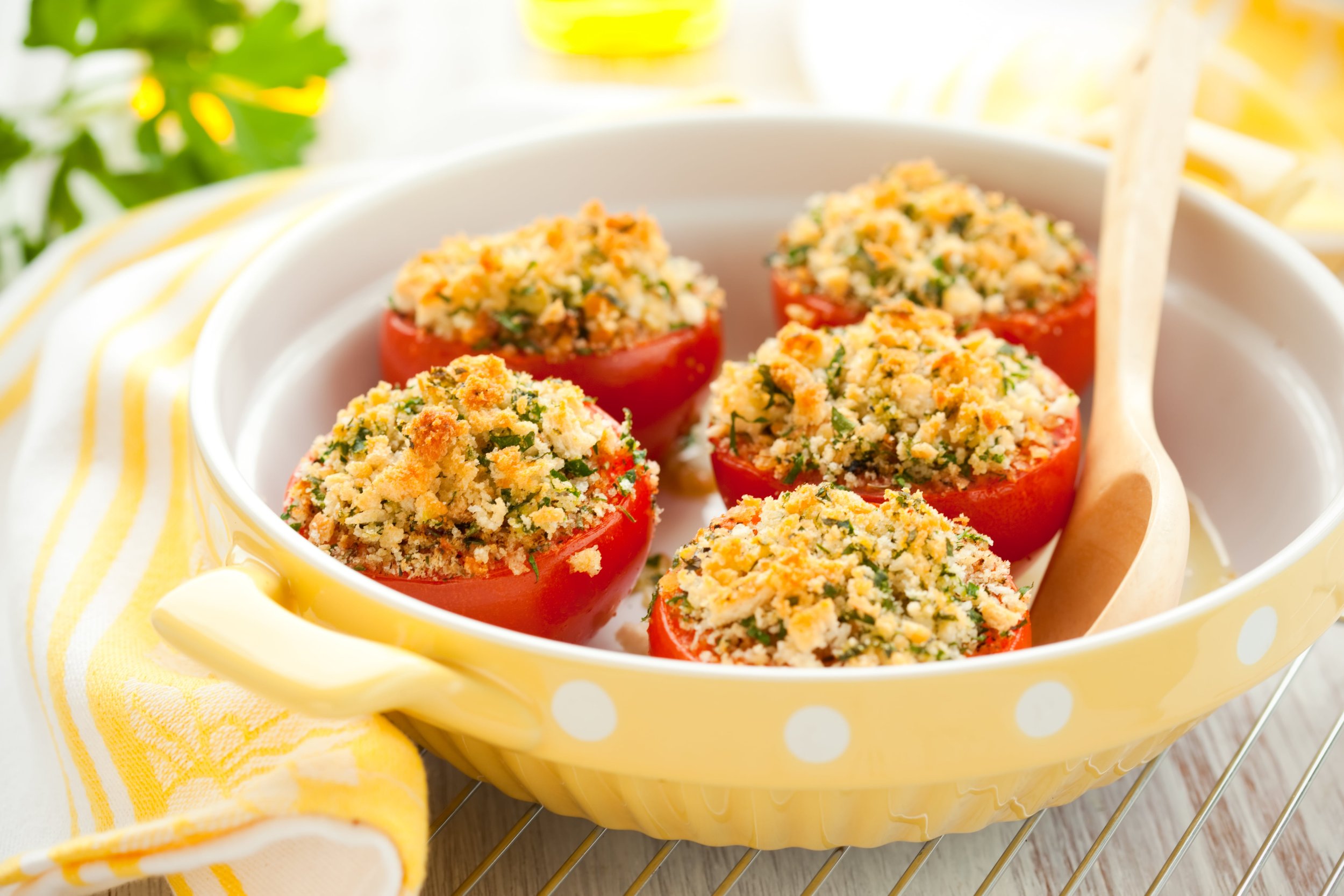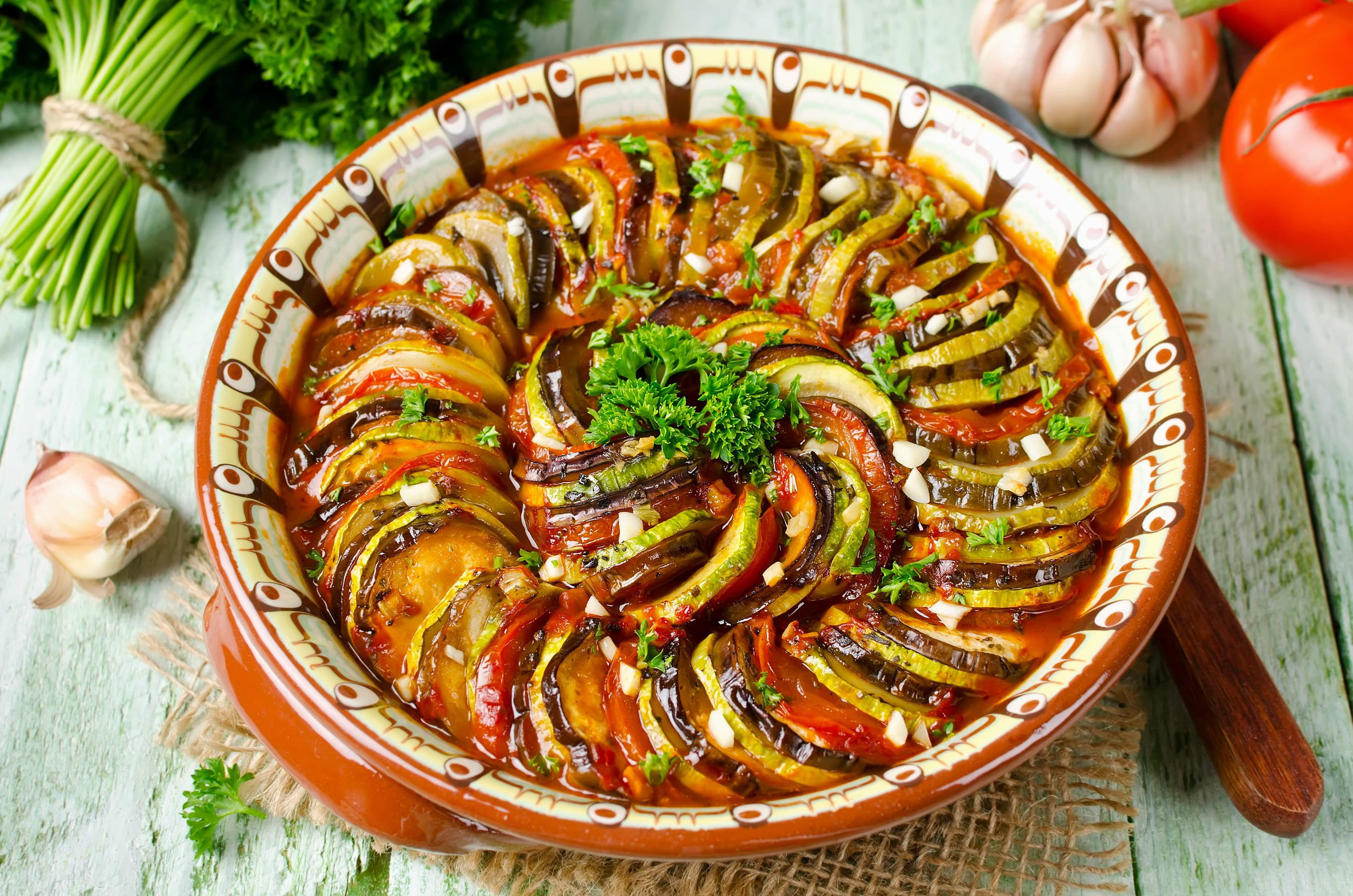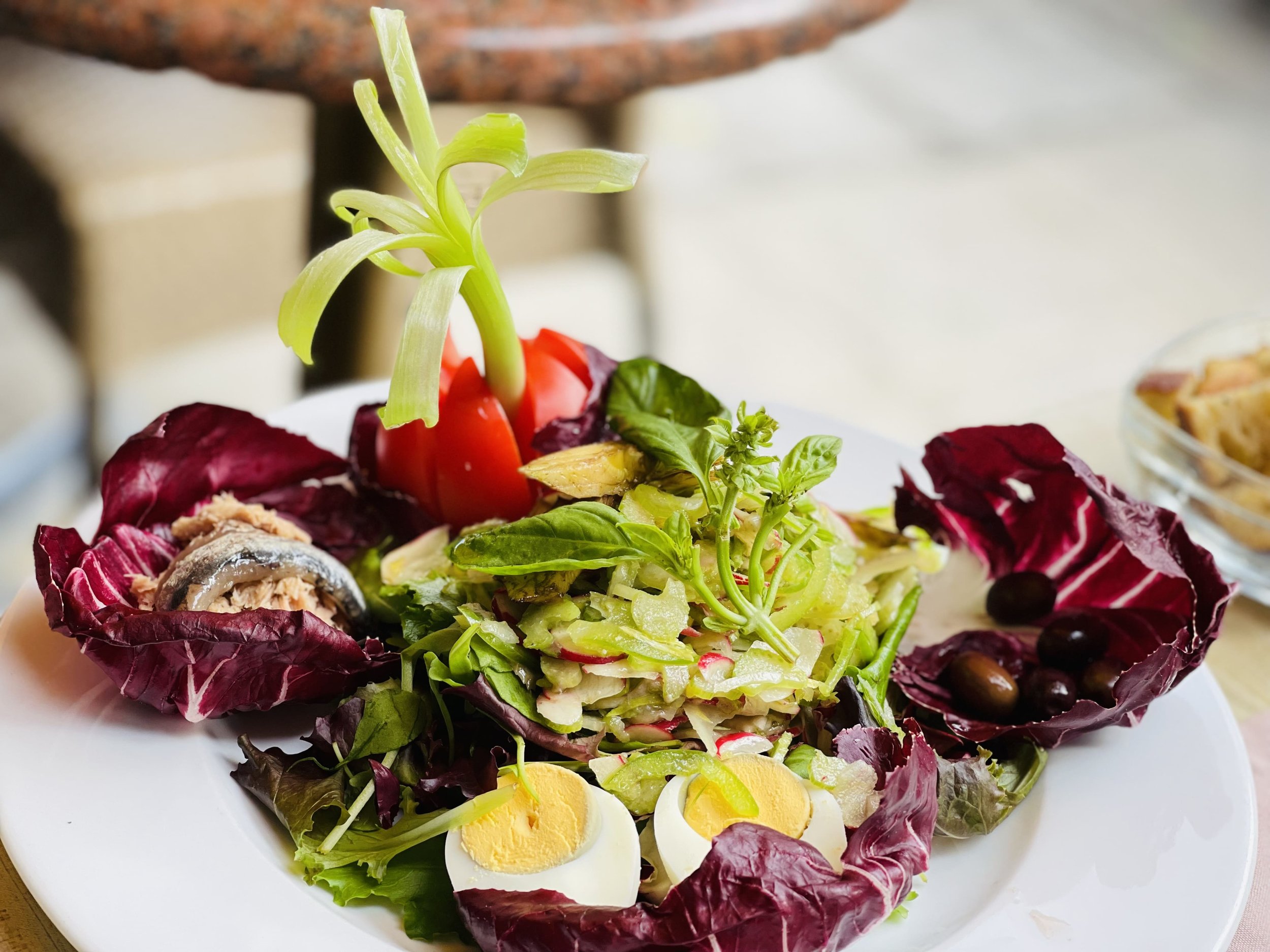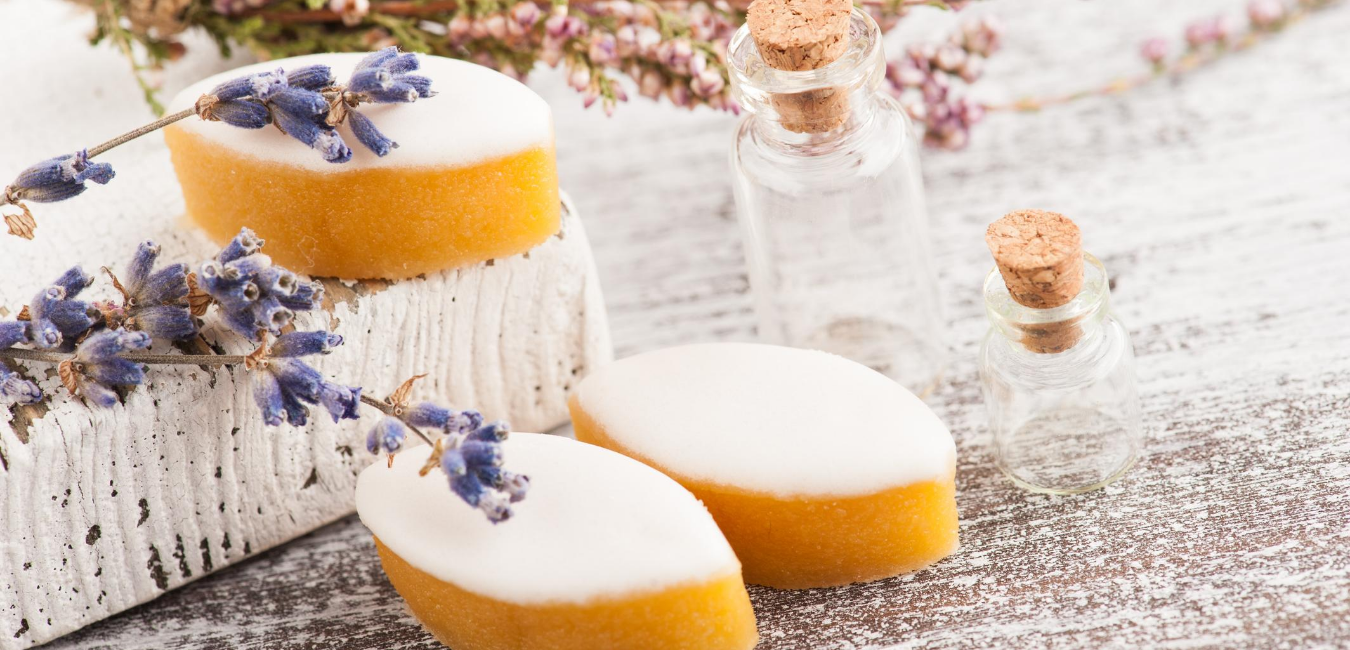Provençal Cuisine: The Must-Eat Food of Provence
Want to know the Provençal foods you must try? This guide to Provençal cuisine highlights all of the traditional dishes of the region. From sauces and seafood, to vegetables and meats, to breads and desserts, you’ll have everything you need to know to enjoy the best food Provence has to offer.
Provençal Food
Visiting the Provence-Alpes-Côte d'Azur region in the southeast of France is a feast for the senses. Of course, coming from a chef and a foodie, this article focuses on the sense of taste and the delicious food of Provence, France.
I have visited the region many times, the last time for a month, and I never tire of the local cuisine or wines.
The cuisine of Provence is heavily influenced by the region’s geographical location. Provence starts at the Italian border with the French Riviera and extends north into the nearby hills and east just past Marseille.
Another aspect affecting Provençal gastronomy is the fact that French cuisine is highly regional. So, the food in Provence, France, differs from that of other regions and, of course, from the classic dishes of Paris.
Provençal dishes have influences from both Mediterranean and Italian cuisine. They also include the specialties from the ancient cuisine Nissarde and more modern Niçoise cuisine.
If you’re like me, you’ll want to try as many Provençal foods as you can. But first, let’s start with the local ingredients you will encounter.
Ingredients of Provençal Cuisine
Provençal cuisine is known for its simple yet flavorful dishes that showcase the natural flavors of fresh local ingredients. You’ll notice many of the ingredients at the core of the food in Provence overlap with the ingredients commonly associated with the Mediterranean diet: seafood, vegetables, and olive oil.
Herbes de Provence
Herbes de Provence is a signature blend of dried herbs that is commonly used to season Provençal foods. In olden times, people would gather herbs in the hillsides of Provence and dry them for later use in cooking. There was no recipe—whatever was available was used.
Today, the herb blend typically includes thyme, rosemary, oregano, and savory, but can also include other aromatic herbs such as marjoram and basil. In North America, lavender is usually added.
Herbes de Provence is often used to flavor grilled meats, fish, and vegetables in addition to stews and soups.
Lavender
The lavender fields of Provence not only provide picturesque landscapes but serve as home to an important ingredient of the Provence region.
One of the classic flavors of Provence, lavender adds a floral flavor to honey, ice cream, breads, and more savory traditional dishes. The flowers can also be used to make tea or can be added to cocktails for a unique twist.
Chickpea Flour
In case it’s not obvious, chickpea flour (farine de pois chiches) is a gluten-free flour made from ground chickpeas. If that sounds unusual to you, it may help to know chickpea flour is popular within Mediterranean cuisine, including in some regions of Italy.
Since Provence cuisine has been influenced by both the wider Mediterranean region and Provence’s immediate neighbor Italy, it’s not a surprise that we would find chickpea flour in southeastern France. Or that it is used to make some of the must-try foods of Provence!
Fleur de Sel
The name "flower of salt" comes from the way salt crystals form on the surface of the water during the evaporation process used to harvest salt; the crystals resemble delicate flower petals.
Specifically, fleur de sel is the high-quality salt that comes from the coastal regions of southern France. It is harvested by hand using traditional methods that have been passed down for generations.
Provençal Olive Oil and Olives de Provence
As in Tuscany, olive trees grow well on the hillsides of Provence. And just like in Tuscan cuisine, the use of olive oil is quite common in the preparation of foods throughout Provence. Indeed, it is so common that it is used in almost every savory Provençal dish.
In fact, one of the biggest differences between the cuisine of Provence and French food in other regions is that you’ll find much more olive oil than butter in the preparation of Provence foods.
Olives also feature prominently in Provençal cooking. You’ll find more black olives than green, but both are consumed as a snack and are used in Provençal recipes. Many restaurants in Nice and the surrounding areas will serve a small bowl of Niçoise olives with bread at the beginning of a meal.
Black Truffles
Truffles make me swoon, and it’s no coincidence that many of my favorite foodie destinations are places famous for truffles.
Black truffles are a highly coveted culinary delicacy that are considered to be a true symbol of Provence's gastronomic heritage. These precious black diamonds are found in the limestone soil of the rolling hillsides in the region.
The truffle season in Provence begins in late autumn and lasts until the end of winter. The flavorful fungi are traditionally harvested with the help of specially trained dogs or pigs that can sniff out their earthy scent. Foodies know this makes wintertime a great time to visit Provence.
Provençal Seafood
With seafood, freshness makes all the difference! And since the cities of the Côte d’Azur have the bounty of the Mediterranean Sea right at their fingertips, it is no wonder that its many treasures feature prominently in the local cuisine.
Fish dishes with sea bream (daurade), Jon Dory, sea bass (loup de mer), and red mullet (rouget) are all very popular. In addition, clams, mussels, scallops, octopus, and squid all find their way onto Provençal menus—as do some of the weirder French seafoods like bulots (whelks) and raw urchin.
In this part of France, you will probably also see more anchovies (anchois) and sardines than you’re used to. Even if you don’t think you like them, try a new preparation while visiting—you may just end up with with a favorite new food to crave.
Fresh Vegetables
The region's sunny Mediterranean climate allows for an abundance of produce year-round, including tomatoes, zucchini, eggplant, bell peppers, onions, artichokes, garlic, and much more.
I love going to the local markets to see all the local varieties of vegetables and what’s in season. Aix-en-Provence, Antibes, and Avignon all have wonderful markets, but the one at Cours Saleya in Nice is my personal favorite.
Must-Eat Food of Provence
For me, the best food in Provence is the authentic dishes that have been made for centuries in the region. So, my list of must-eat foods is in large part a list of the most traditional dishes of Provence.
If you find yourself in Nice, there are some wonderful Nice food tours that introduce you to many of the specialties of Provence. In the meantime, here’s a peek at what to look forward to.
Vegetable-Centric Provence Foods
Tomates à la Provençale
Tomates à la Provençale, or “Tomatoes the Provençal Way,” is a dish that bursts with the flavors of the region. This classic preparation consists of ripe tomatoes that are stuffed with breadcrumbs, garlic, olive oil, and herbs, and then baked until their tops are golden brown.
These are commonly served as a side dish or appetizer in restaurants throughout the region. Some restaurants even use a small portion as a garnish to brighten up the plate and add a little extra taste of Provence to dishes.
Soupe au Pistou
Soupe au Pistou is a classic vegetable soup, typically featuring a variety of fresh produce such as green beans, zucchini, tomatoes, carrots, and onions. The main ingredient that gives the soup its unique flavor and texture is Pistou, which is the French equivalent of pesto.
The sauce is made with garlic, basil, olive oil, and grated Parmesan cheese, and is added to the soup just before serving.
The history of Soupe au Pistou is intertwined with the history of the Mediterranean region. It is believed that the dish first originated in Liguria, Italy, the region known for pesto. It then traveled to France, where it was adapted and became a staple of Provençal cuisine.
Ratatouille
Ratatouille is a typical Provence food that originated in Nice. This vegetable medley features eggplant (aubergine), zucchini (courgette), bell peppers (poivrons), onions (oignons), and tomatoes (tomates) cooked together in a savory sauce made with olive oil and herbs such as thyme and rosemary.
Today, French chefs make this peasant food from Provence look like artwork. However, originally, poor farmers combined leftovers with odds and ends to make a less attractive vegetable stew. With no set ratatouille recipe, this traditional dish turned out different every time.
Artichauts à la Barigoule
Artichauts à la Barigoule is a classic Provençal dish made with artichokes, onions, carrots, celery, garlic, white wine, and salted pork or bacon. It is a staple of Provencal cuisine and is eaten as a starter or a light main course.
For those of you who are thinking about dipping leaves and eating the tender ends, you may be disappointed to find out that the leaves get discarded for this dish. But trust me, you will not be disappointed: The stems are tender and yummy!
Beignets de Fleurs de Courgettes
Beignets de Fleurs de Courgettes, or zucchini flower fritters, are a must-try savory dish from Provence. These fritters are made by dipping zucchini flowers in a batter made from flour, eggs, milk, and herbs before frying them until they are crispy on the outside.
Zucchini flower fritters can be served as an appetizer or as a side to a main course. They are often stuffed with cheese or served with a side of aioli sauce for added flavor.
Panisse
One of my favorite Provence foods, panisse, are often referred to as chickpea fries. Panisse can be served as an appetizer or side dish and pairs well with other traditional Provençal dishes such as ratatouille or tapenade.
This tasty treat combines chickpea flour with water and olive oil until the mixture thickens into a dough-like consistency. The mixture is then poured into a pan and allowed to cool before being cut into slices similar to steak fries. The slices are then fried. These chickpea fries have a crispy exterior that gives way to a soft, velvety interior rich with the flavor of chickpeas.
The history of panisse is steeped in tradition and legend. Some say that it was created by the ancient Greeks or Romans, while others believe that it was developed by the Moors. Regardless of its origins, panisse has become an integral part of Provençal cuisine.
Seafood Dishes of Provençal Cuisine
Salade Niçoise
Salade Niçoise, also known as Nice Salad, is a classic French dish that, as the name strongly hints, originates from the city of Nice. It is a colorful and vibrant salad that is served cold and is considered a complete meal commonly served for lunch or dinner.
The authentic Salade Niçoise consists of ripe tomatoes, olives, anchovy fillets, hard-boiled eggs, and tuna. The salad is typically dressed with an olive oil and lemon dressing or a vinaigrette made with mustard, garlic, and red wine vinegar.
Brandade de Morue
The popular Provençal dish Brandade de Morue is made with salt cod (morue salée), olive oil, and garlic. The salt cod must first be soaked overnight. It is then poached, drained, and mashed together with olive oil and garlic until it has reached a smooth paste-like consistency.
This creamy spread can be served with bread and/or potatoes as an appetizer or as part of a larger meal.
Bouillabaisse
Bouillabaisse is a rich fish stew that originated in the port city of Marseille, way back in 600 B.C., when the city was part of Greece! The origins of bouillabaisse can be traced back to the fishermen who would prepare this dish using the catch of the day that they were unable to sell at market.
This signature dish of Marseille is made with a variety of fish, shellfish, and vegetables, which are simmered together in a flavorful broth made from fish stock, tomatoes, garlic, fennel, onions, thyme, and saffron. Traditionally, bouillabaisse is served with rouille, a garlicky mayonnaise-like sauce that is spread on slices of crusty bread.
In Marseille, authentic Bouillabaisse restaurants formed a charter whose members pledge to adhere to regulations requiring the use of specific ingredients and the maintenance of certain traditions in the preparation and presentation of Bouillabaisse. One of the rules restaurateurs must follow—the fish must be removed from the Bouillabaisse once it is done and cut in front of the guest before serving.
Aïoli Provençal Complet
One of the most popular Provençal dishes has three names: Aïoli Provençal Complet, Grand Aïoli, and Grand Aïoli Provençal. It is not another version of aïoli sauce. It’s a complete meal that includes seafood, vegetables, and the popular sauce by the same name (see below).
As with so many recipes for Provence foods, this one tends to vary. The staple vegetables include potato, artichoke, green beans, carrots, and cauliflower. The seafood is usually a combination of fish and shellfish. The dish can be a pretty hearty meal so it is often shared.
Bread-like Foods of Provence
Socca
Socca is a popular street food in Nice that has been enjoyed by locals for centuries. This thin pancake is made from chickpea flour, water, olive oil, and salt. The batter is poured onto a copper skillet and cooked until crispy on both sides. The best soccas in Nice are cooked in wood-fired ovens.
As a snack, socca can be served plain in a paper cone sprinkled with pepper. It's often also eaten as an appetizer but can also be enjoyed as part of a larger meal.
Pissaladière
Pissaladière is a savory tart that is often referred to as a pizza. To me, it’s more a flat bread and nothing like the pizzas I order. The crust is typically made from bread dough rather than pizza dough, there’s no sauce, and the toppings are not flexible: caramelized onions, anchovies, and black olives.
The origins of pissaladière can be traced back to Nice, where it was traditionally eaten as a snack by fishermen. Today, it's enjoyed throughout Provence and beyond as a hearty appetizer or light lunch.
Fougasse
The popular Provence food, fougasse, is a flat, rustic bread that is often shaped like a leaf or ear of wheat. Fougasse is crispy on the outside and tender on the inside. It has a slightly salty flavor and is typically seasoned with herbs like rosemary, thyme, or oregano.
Many variations of this bread exist, and other ingredients like olives, cheese, anchovies, and herbs can be added to create different flavors. I always choose the olive fougasse.
The history of fougasse is closely tied to the customs and traditions of Provence. In the past, fougasse was often made for special occasions and celebrations, such as weddings or religious holidays. The bread was often decorated with symbolic shapes or designs, such as a cross, a wheat sheaf, or a heart. In some regions of Provence, fougasse was even used as a form of payment or given as a gift.
Sauces, Dips, & Cheese of Cuisine Provençale
À la Provençale
À la Provençale means “in the style of Provence.” It does not refer to a single dish, or a Provençal sauce per se, but to the preparation method.
You will see chicken, pastas, and different types of fresh fish “à la Provencal.” At its most basic, this means they combine two key Provençal ingredients: garlic and olive oil. Some Provençal chefs will add tomatoes or olives, or both.
Aïoli
The name aïoli comes from the word "ail," which means “garlic” in French, and "oli" which is the Occitan word for “oil.” As the name suggests, garlic and oil are the main ingredients in aïoli. They are combined with egg yolks and lemon juice or vinegar to create a creamy texture, similar to that of a garlic mayonnaise.
This staple of Provençal cuisine can be used as a condiment or a dipping sauce. Its garlicky flavor is robust and savory, making it an ideal accompaniment for seafood, grilled meats, and vegetables. Aïoli is also a great addition to sandwiches, burgers, and pasta dishes.
Anchoïade
The key ingredient to the traditional dip from Provence, anchoïade, is anchovies. These small fish are packed with flavor and provide a salty base for the dip. Garlic adds a pungent kick while olive oil provides richness and depth.
This dip is typically served with raw vegetables or bread as an appetizer. I first tasted anchoïade at the Colombe d’Or on a day trip from Nice to Saint Paul de Vence. The restaurant served it with French breakfast radishes, which I thought was a perfect combination.
If you like it, you’ll love our Smoked Fish Dip recipe!
Tapenade
Tapenade is an olive-based spread or dip that originated in Provence but has since become popular throughout France and beyond.
It typically includes black olives, capers, anchovies, garlic, lemon juice, and olive oil. Vegetarians should note that this olive dip is not usually meat free since traditional recipes contain fish.
Tapenade can be served as an appetizer or condiment and is often spread on slices of bread or crackers. It's also commonly used as a topping for grilled meats, fish, or vegetables.
Banon Cheese
Banon cheese, a soft cheese made from raw goat's milk, is one of the most popular and well-known fromages from Provence. The small wheel has a distinctive light gray rind that is wrapped in chestnut leaves.
Banon cheese has been produced in the Provence hills since Roman times, and in 2003 it earned AOC status. If you can only try one cheese in Provence, it should be Banon!
Traditional Meat Dishes of Provence
Gardiane de Boeuf
Gardiane de Boeuf hails from the Camargue region of Provence, where it was originally made with only bull meat. It consists of chunky pieces of beef slowly cooked with potatoes, carrots, onions, and tomatoes in red wine and aromatic spices.
The result is a hearty stew with rich and complex flavors and a thick velvety sauce. The dish is typically served in the winter months with crusty bread and accompanied by a glass of robust red wine.
Boeuf Daube
If you are looking for a classic comfort food for a cold day, then daube is the perfect Provencal food for you. This hearty beef stew is typically made with onions, garlic, carrots, celery, tomatoes, and herbs such as bay leaves and thyme. What sets daube apart from other beef stews is the addition of red wine, clove, and orange peel, which gives the dish a unique flavor.
The name “boeuf daube” translates to “beef in a terra cotta pot.” The best daubes will cook low and slow in the pot until the meat is tender enough to fall apart easily and melt in your mouth. The beef can be served solo, but very often in Provence cuisine, you’ll find it ladled over raviolis.
Delectable Desserts of Provence
Nougat
One of the most popular sweets in Provence is nougat. This classic French confection is made by combining sugar, honey, whipped egg whites, and almonds or pistachios. The mixture is then cooked until it reaches a chewy consistency before being cut into bite-sized pieces.
Nougat was originally made by Arab confectioners who brought their recipe to Europe during the Middle Ages. Today, Provence-style nougat is still popular, and you can find entire stores dedicated to it.
Fruit Confit, aka Candied Fruit
Fruit confit is a popular Provençal sweet. Making fruit confit was originally used as a method of preservation. It involves simmering the fruit in sugar syrup until it has absorbed all the liquid and becomes candied and chewy.
These treats can be enjoyed on their own or used as an ingredient. In Provence, candied fruits add flavor to cakes, tarts, or even savory dishes like roasted meats.
Calissons
One of the Aix-en-Provence food specialties, calissons dates back to the 12th century, when Provence was ruled by the Moors.
They used almond paste as a base and added a delicious mixture of candied melon and orange peel, along with sugar and egg whites, before covering these confections with a layer of icing. Calissons are usually almond or oval-shaped, small and smooth with a firm, chewy texture.
Pompe à l’Huile
Olive oil not only plays a prominent role in many savory Provençal dishes, but also in desserts. One such example is pompe à l’huile—a traditional Provençal dessert made with olive oil instead of butter.
Sometimes referred to as a sweet bread instead of a cake, it has a light texture and subtle flavor that pairs perfectly with coffee or tea. It can be found in many bakeries throughout the region, especially during the Christmas holiday season.
Tarte Tropézienne
If you're searching for a more modern dessert, look no further than the Tarte Tropézienne. This famous dessert was created in 1955 by Alexandre Micka, a Polish pastry chef who had recently moved to Saint-Tropez.
Tarte Tropézienne consists of a brioche filled with a mixture of whipped cream and pastry cream. It is said that the name "Tropézienne" was in honor of Brigitte Bardot, who was filming “And God Created Woman” in Saint-Tropez at the time the dessert was created and fell in love with it.
Ice Cream
Of course, no list of Provençal desserts would be complete without mentioning ice cream. While you can find classic flavors like vanilla and chocolate at many shops throughout the region, there are also plenty of unique options to try.
Lavender ice cream is particularly popular in Provence, as is olive oil ice cream. These may sound like unusual flavors, but they are surprisingly delicious and worth trying if you have the chance.
Check Out the Best Nice Food Tours Now
*
Check Out the Best Nice Food Tours Now *
What to Drink in Provence?
Provence has the longest history of winemaking in France, dating back over 2,000 years. Today, Provence is known for producing some of the best wines in the world from nine AOC wine regions, the three largest being Côtes de Provence, Côteaux d’Aix-en-Provence, and Coteaux Varois en Provence.
So, whether you’re wine tasting at the vineyards and wineries, or ordering a glass at a restaurant or café, wine is a great option to toast the fact that you are in Provence!
Rosé Wines
Provence’s answer to a hot summer’s day is rosé wine! Not only is this area the birthplace of rosé wine, it has established, and continues to maintain, the gold standard for the style.
Provence benefits from a warm, sunny, Mediterranean climate that is perfect for growing grapes. The region is known for its production of dry, crisp, and refreshing rosé wines that are enjoyed by wine lovers around the world.
These wines are made from a blend of grape varieties, including Grenache, Cinsault, Syrah, and Mourvèdre, and are often described as having flavors of red berries, citrus, and Mediterranean herbs. Do not leave the south of France without enjoying glass of good Provençal rosé.
White Wines
Although almost 90% of vineyard acreage in Provence is dedicated to growing grapes used to produce rosés, I can say from experience that even the least expensive white wine in Provence is excellent.
Although there is a good number of different white varietals in the region, the biggest player is undoubtedly the Vermentino grape, also known as Rolle, which thrives in the sunny climate of the region. This grape produces wines that are lively, bright, and full of citrus and floral aromas, making them perfect for sipping on a warm summer day.
Another key player in the white wine game in Provence, the Clairette grape produces wines with a slightly richer body and flavors of ripe stone fruits and a touch of honey. Pair these wines with some of the local seafood bounty, and you've got yourself an unforgettable meal.
Red Wines
Although Provence leans heavily toward rosés and whites, the region is also home to one of France’s most famous red-wine appellations: Châteauneuf-du-Pape.
That means that these celebrated wines from the southern reaches of the Côtes du Rhône are a must-try for any wine enthusiast. This region produces some of the finest red wines in France, known for their rich and full-bodied taste and spicy, earthy aromas of red berries, black pepper, and leather.
Pastis
As the day winds down in Provence, locals gather at cafés and bars to enjoy an apéritif, a traditional pre-dinner drink. And what better way to experience this Provençal tradition than with a glass of Pastis?
Pastis is an anise-flavored liqueur that originated in Marseille over 100 years ago. Its popularity spread throughout France, while retaining a special place of honor among the people of Provence. Typically mixed with water and served over ice before dinner to stimulate the appetite and encourage conversation, Pastis is not just a drink but a symbol of Provençal culture and way of life. Sitting down with friends or family for a refreshing glass in the late afternoon remains a cherished ritual in the region.
Dessert Wine
Muscat de Beaumes-de-Venise is a sweet dessert wine made from Muscat grapes grown on steep slopes near Mont Ventoux, the highest mountain in all of Provence. This wine has a floral aroma and pairs well with fruit tarts or cheese. It’s a wonderful note on which to end a delightful meal.
No matter your preferences, there are plenty of tempting tipples to enjoy before, during, or after the magnificent meals you’ll have while exploring the best of Provençal cuisine. À votre santé and bon appétit!

